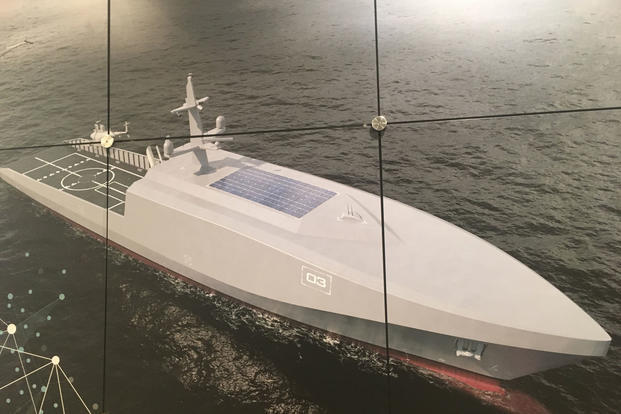As the Navy strives toward its goal of a 355-ship fleet, Chief of Naval Operations Adm. John Richardson has said unmanned systems may be a key to that growth.
For the service's consideration: a fully unmanned ship concept by Rolls-Royce that can spend 100 days at sea without a port visit, and launch and recover unmanned helicopters from a small rear deck.
Last September, Rolls-Royce rolled out the plan for a 60-meter unmanned naval vessel, shown in concept art sporting a sleek stripe and surrounded by quadcopters.
At the Surface Navy Association's annual symposium near Washington, D.C., this week, the company displayed concept art for a variant designed like a Navy ship, with Northrop Grumman MQ-8 Fire Scout unmanned helicopters on its helo deck.
While the Navy is pursuing unmanned surface vessels, such as Textron's Common Unmanned Surface Vehicle, for missions including harbor security and minesweeping, the size of the Rolls-Royce unmanned concept puts it in a separate category.
"I think when you're getting that big, it's a ship," said Davis Sanford, naval campaigns lead for Rolls-Royce.
In addition to providing a launching platform for the Fire Scout, the as-yet unnamed unmanned ship could be used for asymmetric warfare, mine countermeasures, or gear transport, Sanford told Military.com.
It uses electric drive, with four megawatts of power, equipped with generators and solar panels as a backup power source. Sanford said it could operate fully autonomously for 100 days at sea.
The existence of a fully unmanned ship concept raises questions about whether unmanned platforms could actually count toward the Navy's planned 355-ship tally.
Navy leaders have expressed avid interest in unmanned technology, but remain vague about how unmanned systems would be incorporated into the fleet on a broad scale.
"There is no question that unmanned systems must also be an integral part of the future fleet," a May 2017 document outlining Chief of Naval Operations Adm. John Richardson's vision for the future fleet states.
"The advantages such systems offer are even greater when they incorporate autonomy and machine learning," it continues. "And these platforms must be affordable enough to buy them in large numbers, and networked in order to expand our presence in key areas."
On Thursday, the Navy's new head of acquisition, James "Hondo" Geurts, said the answer is still not clear.
"I don't have the details of what's in the count or not," Geurts told reporters. "What I would say with unmanned systems is, I think it has huge potential for the Navy whether that's in the air, on the surface or under. How we talk about that in ship count, I'm not quite sure … I think unmanned systems have the potential to rapidly increase capability we have on both our current capacity of ships, and as we go to 355 ships."
The Rolls-Royce concept might be ready for acquisition by 2025 or 2030, Sanford said. The world will have to evolve rapidly before then; currently, there are no international regulations governing the operation of unmanned ships, which means they cannot enter international waters.
There are other considerations: Sanford said the company is still determining how to make the unmanned ship tamper-proof, to prevent people coming aboard and attempting to control or tamper with the ship.
But the military has already expressed interest in acquiring such technology, whether or not the Navy plans to use it to increase the fleet size.
In September 2017, the Defense Department's Strategic Capabilities Office released a draft solicitation for a program called Overlord: an unmanned surface vehicle that can operate for 90 days at a time, covering at least 4,500 nautical miles at 19 knots or higher.
"That's kind of the smaller side of where we are and where we're hoping to go with our design, our concept, and our technology," Sanford said.
-- Hope Hodge Seck can be reached at hope.seck@military.com. Follow her on Twitter at @HopeSeck.










